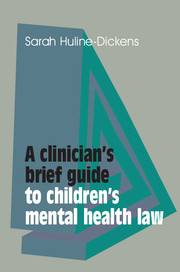Book contents
- Frontmatter
- Contents
- Foreword
- Acknowledgements
- List of cases
- Common abbreviations and terms
- 1 Introducing child mental health and the law
- 2 The rights of the child
- 3 The Children Act 1989 and the 2004 amendments
- 4 Consent to treatment
- 5 Confidentiality
- 6 The Mental Health Act
- 7 The Mental Capacity Act
- 8 Juvenile justice
- References
- Index
8 - Juvenile justice
Published online by Cambridge University Press: 02 January 2018
- Frontmatter
- Contents
- Foreword
- Acknowledgements
- List of cases
- Common abbreviations and terms
- 1 Introducing child mental health and the law
- 2 The rights of the child
- 3 The Children Act 1989 and the 2004 amendments
- 4 Consent to treatment
- 5 Confidentiality
- 6 The Mental Health Act
- 7 The Mental Capacity Act
- 8 Juvenile justice
- References
- Index
Summary
Bowlby's seminal paper on juvenile thieves (Bowlby, 1944) reminds us of the important roots of child psychiatry, which began with the delinquent child. Some 70 years later, the Prison Reform Trust (2016) has published Lord Laming's review into why 61% of 15- to 18-year-old girls and 33% of boys in custody have spent time in care. The review also investigates why, although fewer than 1% of all children in England are in care, looked after children aged between 10 and 17 are five times as likely to be convicted, or subject to a final warning or reprimand, than other children.
Quite apart from ethical and societal considerations, there is a strong economic argument for keeping children and young people out of the socalled secure estate. The number of young people up to the age of 18 held in custody in the secure estate in June 2015 was 986 (Youth Justice Board, 2013a), and the average cost per year for each young person in a secure children's home was £212 000, in a secure training centre it was £178 000 and in a young offender institution was £60 000 (based on 2012–2013 prices; Youth Justice Board, 2013b).
This chapter is not intended to cover ground extensively discussed elsewhere. In particular, there is much written about the forensic services available for children and young people (e.g. Bailey & Delmage, 2010). Report writing is covered in sources such as Richardson & Casswell (2010). This chapter considers more general matters concerning children and young people who may be known to CAMHS and who come into contact with the criminal justice system. Starting with an overview of detention in custody, relevant rights under the European Convention on Human Rights (ECHR) where they apply to youth justice are highlighted. There are some brief notes on secure accommodation and on restraint. The age of criminal responsibility and the very young offender are then discussed, followed by the steps in the process of contact with the criminal justice system, from interviewing with an appropriate adult to participating in a trial and sentencing. Finally, there is a note on the role of the youth offending team and a brief description of the so-called forensic sections of Part III of the MHA.
- Type
- Chapter
- Information
- A Clinician's Brief Guide to Children's Mental Health Law , pp. 108 - 122Publisher: Royal College of PsychiatristsPrint publication year: 2016



